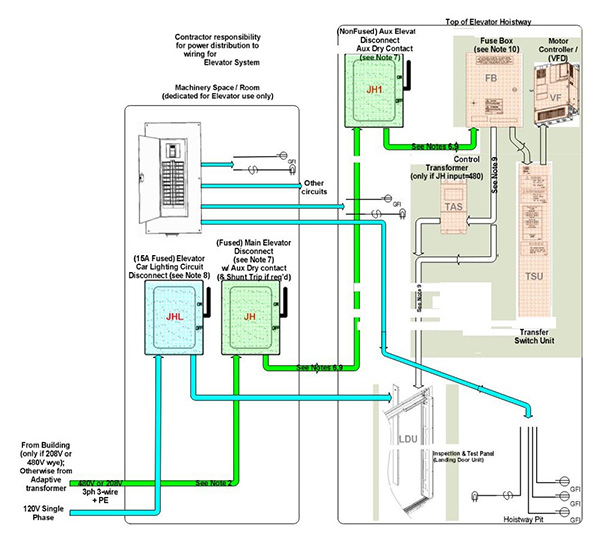Proper design for generators and elevators is imperative for multiple reasons. On some commercial and multi-family projects where there are multiple passenger and freight elevators as well as a legally required or emergency standby generator set to supply them, it is critical that the MEP (Mechanical, Electrical, and Plumbing) engineers be provided with the specific design criteria for each of these systems and associated equipment at the time of initial design and construction document preparation so that the MEP design can be properly configured and coordinated with the Architect to accommodate and properly serve the equipment.
Unfortunately, this critical design information is often not available at the time of initial project design and something other than the actual equipment to be installed is used as the “basis of design”. Elevator and generator manufacturers (as well as many others) are not willing to provide actual specifications or final “shop drawings” for their equipment if and until they have a signed contract and payment from the owner. Often, this does not occur until well after the construction documents have been submitted for plan review and approval.
The lack of this important and very critical design information significantly (and sometimes adversely) affects the project’s design requirements in many ways including physical space requirements and building layout, airflow and exhaust requirements as well as electrical connection and coordination issues. The common design practice in the absence of actual equipment manufacturer specifications, mechanical and plumbing engineers are forced to use inaccurate information to make decisions about room and duct sizes, as well as points and sizes of connection. The electrical engineer must also use inaccurate data for the elevator loads to determine the required generator capacity which often leads to an oversized generator and associated components (overcurrent devices, feeders, and Automatic Transfer Switch) than could possibly otherwise be required if the actual equipment ratings and characteristics were known at the time of initial design.

For the purposes of official plan review and permitting, this approach has been acceptable, but unfortunately results in the need to officially revise the drawings once the actual elevator and generator equipment specifications are finally received and sometimes causes major physical, material and equipment changes to properly address the actual equipment installation unless caught in time prior to any installation or ordering of equipment has occurred. Often, this is not the case and significant installation has already occurred as well as supporting equipment (i.e. electrical service and distribution equipment) is not properly sized or coordinated for the actual elevator(s) and/or generator supplied. Additionally, the need for documenting these changes in an efficient manner is further challenged by the need to meet inspection timeframes and possibly delaying or hindering the issuance of a certificate of occupancy depending on the timing of the process. Hopefully, all of the sequencings are in accordance with the project schedule and do not adversely affect the project.
In a perfect world, this critical design information would be available at the time of initial project design to eliminate the need for any assumptions and potential re-design of two very important and critical pieces to the building puzzle that affect MEP disciplines as well as the architecture and construction of the building. This means that the owner will need to be committed to spending a considerable amount of the project’s budget up front to expedite the delivery of this information from the various equipment vendors at the outset of the project rather than leaving it to the end of the project when timeframes are more critical and construction has potentially advanced to a degree where changes are costing more in time and additional cost than anyone anticipated.
Food for thought going forward. If you would like us to consult on a current, or upcoming project, we would love to assist. Please contact us for more information.







